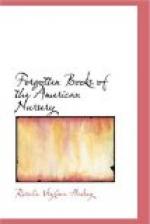These facts, together with the knowledge that Isaiah Thomas was a fair engraver himself, make it possible that his apology for the first impression of the tiny classic was for his own engraving, which he thought to better.
Thomas not only copied and pirated Newbery’s juvenile histories, but he adopted his method of advertising by insertions in the text of these tales. For example, in “The Travels of Robinson Crusoe, Written by Himself,” the little reader was told, “If you learn this Book well and are good, you can buy a larger and more complete History of Mr. Crusoe at your friend the Bookseller’s in Worcester near the Court House.” In “The Mother’s Gift,” there is described well-brought-up Miss Nugent displaying to ill-bred Miss Jones, “a pretty large collection of books neatly bound and nicely kept,” all to be had of Mr. Thomas; and again Mr. Careful, in “Virtue and Vice,” “presented at Christmas time to the sons and daughters of his friends, little Gilt Books to read, such as are sold at Mr. Thomas’ near the Court House in Worcester.”
Thomas and his son continued to send out these toy-books until their gay bindings faded away before the novelty of the printed paper covers of the nineteenth century.
FOOTNOTES:
[92-A] Tyler, Literary History of the American Revolution, vol. i, p. 485.
[94-A] Life of Josiah Quincy, p. 27. Boston, 1866.
[94-B] Earle, Child Life in Colonial Days, p. 171.
[98-A] Tyler, Literature of the American Revolution, vol. ii, p. 182.
[98-B] Ibid., p. 156.
CHAPTER V
1790-1800
By Washington
Great deeds were done.
The New England Primer,
New York, 1794
Line after line their wisdom flows
Page after page repeating.
T.G. HAKE
CHAPTER V
1790-1800
The Child and his Book at the End of the Century
Any attempt to trace the slow development of the American child’s story of the nineteenth century must inevitably be made through the school-books written during the previous one. Before this, English books had been adapted to the American trade. But now the continued interest in education produced text-books pervaded with the American spirit. They cannot, therefore, be ignored as sporadically in the springtime of the young Republic, they, like crocuses, thrust forward in the different states their blue and yellow covers.
Next to clergymen, schoolmasters received the veneration of the people, for learning and godliness went hand in hand. It was the schoolmaster who reinforced the efforts of the parents to make good Americans of the young folks, by compiling text-books which outsold the English ones hitherto used. In the new editions of the old “New England Primer,” laudatory verse about General Washington replaced the alphabet rhyme:




